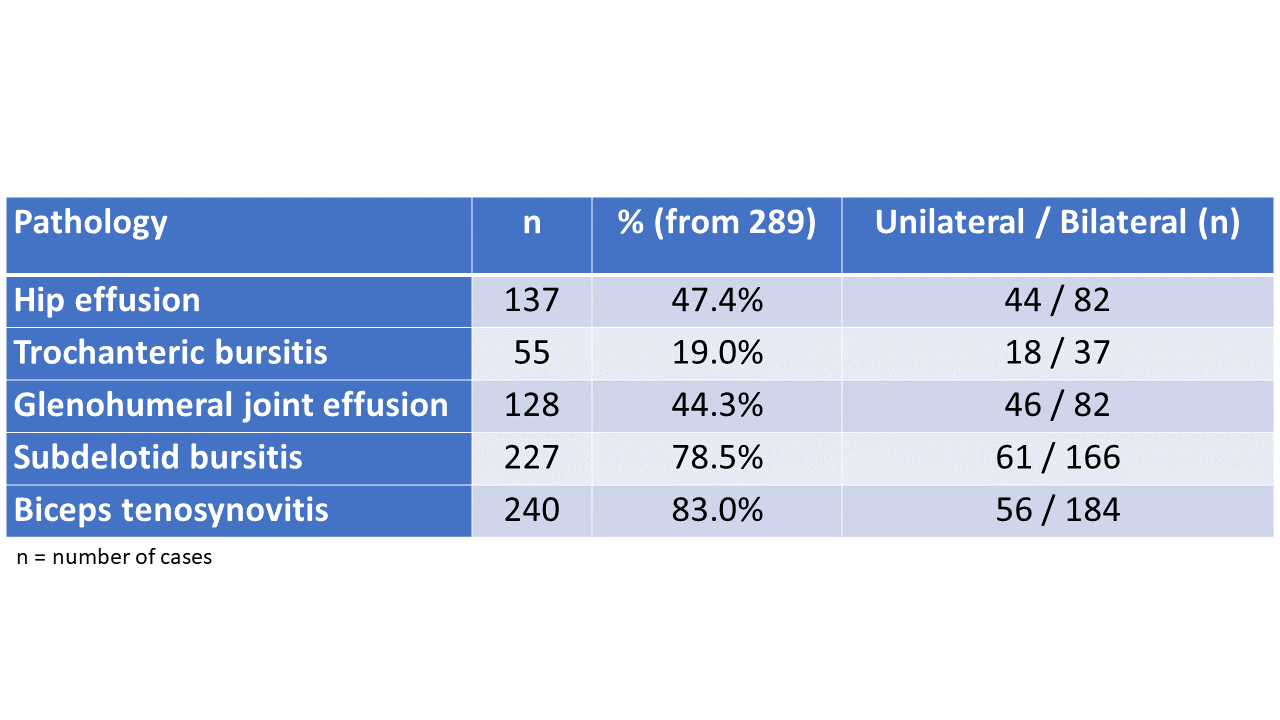Session Information
Session Type: Poster Session B
Session Time: 9:00AM-11:00AM
Background/Purpose: Musculoskeletal ultrasound (US) is a validated method for the objective assessment of the pathological changes occurring in PMR. It assists the diagnosis of the disease and increases the performance of 2012 ACR/EULAR classification criteria for PMR(1). The aim of our international multicenter study was to determine the prevalence of US findings characteristic for PMR in a cohort of newly diagnosed PMR patients.
Methods: Our PMR cohort included 390 consecutive clinically diagnosed patients from eight rheumatology centers.At diagnosis, patients underwent a bilateral US examination of shoulder and hip joints. Only patients who had no missing data were included in the analysis. The presence of joint effusion (hip, glenohumeral), bursitis (subdeltoid, trochanteric) and tenosynovitis (long biceps tendon) was recorded.
Results: A complete US examination was performed in 289 PMR patients. Mean (SD) age was 73.1 (9.7) years and 159 patients were female (55.0%). All PMR patients had at least one pathologic US finding. The presence of biceps tendosynovitis (mostly bilateral) was the most frequently recorded abnormality, disclosed in 240 patients (83.0%). The prevalence of individual pathologic US findings is reported in Table 1. The two US items included in the PMR classification criteria “at least 1 shoulder with subdeltoid bursitis and/or biceps tendosynovitis and/or glenohumeral synovitis and at least 1 hip with synovitis and/or trochanteric bursitis” (item 1) and “bilateral shoulder with subdeltoid bursitis, biceps tendosynovitis, or glenohumeral synovitis” (item 2) were fulfilled in 153 cases (52.9 %) and 269 cases (93.1%), respectively. Patients who fulfilled item 1 of US classification criteria had a higher CRP level compared to those who did not ((mean (SD) CRP 59.4 (48.1)vs 42.0 (40.7) mg/l (p < 0.001) for patients that not fulfilled this item, since No other associations regarding US criteria, sex, age, ESR and CRP were found.
Conclusion: At least one US abnormality of shoulder or hip joints was found in all our PMR patients, with bilateral tendosynovitis of long biceps tendon being the most common finding 83%. Ultrasound PMR classification criteria were met in 52.9% patients for item 1 and in 93.1% patients for item 2.
References:
1 Dasgupta B et al. 2012 provisional classification criteria for polymyalgia rheumatica: a European League Against Rheumatism/American College of Rheumatology collaborative initiative. Ann Rheum Dis. 2012; 71: 484–92.
Acknowledgements: To the GCA/PMR study group
To cite this abstract in AMA style:
Hocevar A, MACCHIONI P, Monjo I, Karalilova R, Conticini E, Tomelleri A, Ponte C, Monti S, Klinowski G, Batalov Z, Falsetti P, Campochiaro C, De Miguel E. The Prevalence of Shoulder and Hip Joints Ultrasound Findings in Polymyalgia Rheumatica: A Multicenter International Study [abstract]. Arthritis Rheumatol. 2023; 75 (suppl 9). https://acrabstracts.org/abstract/the-prevalence-of-shoulder-and-hip-joints-ultrasound-findings-in-polymyalgia-rheumatica-a-multicenter-international-study/. Accessed .« Back to ACR Convergence 2023
ACR Meeting Abstracts - https://acrabstracts.org/abstract/the-prevalence-of-shoulder-and-hip-joints-ultrasound-findings-in-polymyalgia-rheumatica-a-multicenter-international-study/

